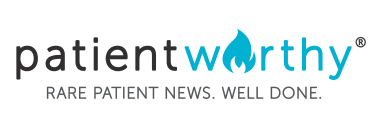Acknowledgment: This patient story is sponsored by Day One Biopharmaceuticals and is promoted through the Patient Worthy Collaborative Content program. We only publish content that embodies our mission of providing relevant, vetted, and valuable information to patient communities. If you are interested in sharing your story, please click here.
For most kids, missing school is a dream come true. Not for Gabby. Gabby would go to school 24/7 if she could. But when she was 10 years old, Gabby had to spend 5 days in the hospital instead. She was diagnosed with the flu and went home with some lingering symptoms— headache and fatigue. But Gabby and her family would soon find a more serious diagnosis was hiding beneath the surface: devastatingly, Gabby was suffering from a brain tumor.
Every year, about 1700 children are diagnosed with pediatric low-grade glioma, or pLGG. It’s the most common brain tumor in children. pLGG can cause problems with speech, vision and motor function. Mood disorders and unexplained weight loss or gain can occur, too. But until recently, treatment options were limited. Most pLGG treatments, including chemotherapies and certain targeted therapies, were only approved by the US Food and Drug Administration (FDA) for use in adults.
Here you’ll read the story of Gabby and her mom Mandy, and how they fought valiantly for Gabby’s health and future from the beginning.
A battle begun
Gabby has always marched to the beat of her own awesome drum. As a child, she’d scoff at the Barbie section of the toy store and make a beeline for the Monster High Dolls. She wasn’t a moody, antisocial preteen—she gave out hugs at the grocery store. She dreams of becoming a mystery novel writer. That is, if she has time in between taking care of the goats, ducks, chickens, Icelandic sheep, pot-bellied pigs, dogs and cats on her family’s homestead.
Gabby’s journey with pLGG began when she was just 10 years old. Now an 18-year-old young woman, it’s safe to say Gabby’s childhood was just as unique as she is.
It started with her 5-day stay at the hospital for the flu. When she finally came home, Gabby was too tired to go to school. The next day, she suddenly collapsed. Mandy rushed Gabby to the ER for a CT scan, desperate to help her little girl.
After what felt like an eternity, Gabby’s doctor gave her the results, “Sorry that took so long,” he said. “I was getting a helicopter to airlift her to another hospital. Your daughter has a brain tumor the size of an egg—she needs surgery immediately.”
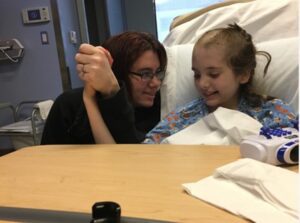
A warrior emerges
After 2 surgeries, a series of complications and 16 days in the Pediatric Intensive Care Unit (PICU), Gabby was diagnosed with pLGG.
The next period of Gabby’s life would be defined by a rigorous and seemingly unending litany of tests and treatments. Taking care of Gabby became Mandy’s full-time job. She was told she had to resign from her other full-time job. The weight of having a child with pLGG began to wear on the entire family. Gabby’s father worked 2 jobs on top of keeping after the family homestead. Gabby’s siblings had to grow up faster, supporting their parents and sister in whatever ways they could.
Mandy took Gabby to brain scans and, each time, she was wracked with anxiety that the scans would reveal more bad news. Gabby had several more brain surgeries, but her grueling treatments didn’t end there. While each child’s journey is unique, about half of those diagnosed with pLGG who undergo surgery will relapse and require additional treatments. Devastatingly, Gabby was one of them. During her preteen years—which should have been filled with birthday parties, yearbook club and sleepovers—Gabby endured rounds and rounds of chemotherapy. She went to the hospital every other week. She missed a lot of school. She missed a lot of childhood.
But despite bearing a burden far too heavy for any child to carry, Gabby stayed strong and stayed true to herself. Gabby soon adopted the nickname “shield-maiden” as her half-shaved head gave her the appearance of a warrior Viking. She wasn’t able to give out her famous hugs in the PICU. So she invented a new way to brighten people’s days. She handed out “Gabby’s Hugs”—milk chocolate candies coated in a sweet white shell—to anyone and everyone she met.
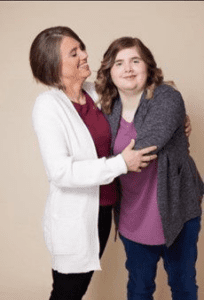
Mom leads the charge
Soon, Gabby had a period of stability in her health. Things went back to almost normal for a while. But in 2021, a scan revealed more devastating news. Gabby’s tumor had grown. Mandy knew she had to do something. She remembered discussing another option with Gabby’s oncologist a little while back, but they had decided to go a different route. Mandy tried to find it again.
Mandy pored over medical journals and found the investigational drug she was looking for— tovorafenib, developed by Day One Biopharmaceuticals.
Mandy read that tovorafenib was being studied in a clinical trial in children with pediatric low-grade glioma who either had a fusion or a V600E change in the BRAF gene. She read that it could be taken at home, just once a week. And she read that it was specifically designed for children—it wasn’t for adults with an adjusted dose. She met with Gabby’s oncologist to see if Gabby was the right candidate for this investigational drug.
For the first time in a long time, Mandy felt hopeful again.
See important Safety Information below.
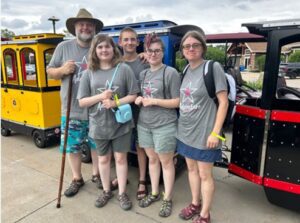
Marching forward
Gabby began tovorafenib in October 2021. She took it for 2 years and for the majority of the time went for monthly lab tests and MRI scans every 3 months to monitor her results. “It was a big win that she could take it at home,” Mandy says. “She didn’t have to miss school every week to get treatment at the doctor’s office.”
Gabby did experience several side effects: rash, nausea, vomiting, hair color changes and fatigue. Twice, Gabby threw up her dose. Over time, her hair, eyelashes and eyebrows turned white. True to herself, Gabby embraced what made her different, “I look like a superhero!” she said of her new silver locks.
In 2024, the US FDA granted accelerated approval for tovorafenib. It got its official name: OJEMDA™ (tovorafenib), the first and only prescription medicine for children 6 months or older living with pediatric low-grade glioma (pLGG) that returned or did not respond to treatment and who have certain changes in the BRAF gene.
In addition to the side effects Gabby experienced, other potential common side effects of OJEMDA include viral infection, headache, fever, dry skin, constipation, acne and upper respiratory tract infection. OJEMDA may cause serious side effects, including bleeding problems (hemorrhage), skin reactions, including sensitivity to sunlight (photosensitivity), liver problems, and slowed growth in children.
The shield-maiden’s triumph
Two years later, Gabby finished tovorafenib in November 2023. Her tumor had shrunk and then stopped growing.
Now, Gabby sees her doctor monthly. Her tumor continues to be stable, and Gabby goes for regular MRI scans to make sure it’s staying that way.
Since then, Gabby’s life on her family’s homestead goes on. She’s still taking care of her dog Haven and helping out with all the other animals. Her love for school stays strong. She began 12th grade with the goal of attending every single day of her senior year—shielding her classmates from boredom with every hug.
Most importantly, Gabby’s still uniquely herself. In her own words, “I am who I am and I’m not going to be anyone else.”
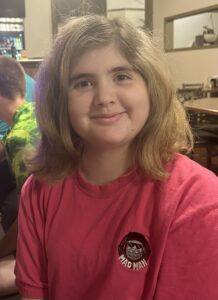
A proclamation
With Gabby focused on her studies, Mandy’s on a new mission. She’s encouraging families of kids with pLGG to talk about treatment options with their doctors—and to advocate for their children’s health.
“Be open to new options,” she reflects, “Opportunities are out there. Have faith in your child’s care team.”
If you’re caring for a child with pLGG, be sure to discuss OJEMDA™ as a treatment option with your child’s healthcare team. Read the full Important Safety Information below. Every patient’s experience might be different. Learn more about results with OJEMDA™ and find answers to frequently asked questions at ojemda.com.
INDICATION
What is OJEMDA™ (tovorafenib)?
OJEMDA is a prescription medicine used to treat certain types of brain tumors (cancers) called gliomas in patients 6 months and older:
- that is a pediatric low-grade glioma (LGG), and
- that has come back after previous treatment or has not responded to previous treatment
and
- that has a certain type of abnormal “BRAF”
IMPORTANT SAFETY INFORMATION
Before taking or giving OJEMDA, tell your healthcare provider about all of your or your child’s medical conditions, including if you:
- have bleeding, skin, or liver problems
- are pregnant or plan to become OJEMDA can harm your unborn baby.
Females who are able to become pregnant:
-
- You should use effective non-hormonal birth control (contraception) during treatment with OJEMDA and for 28 days after your last dose of OJEMDA.
Males with female partners who are able to become pregnant should use effective non-hormonal birth control (contraception) during treatment with OJEMDA and for 2 weeks after your last dose of OJEMDA.
- are breastfeeding or plan to breastfeed. Do not breastfeed during treatment and for 2 weeks after your last dose of OJEMDA.
Tell your healthcare provider about all the medicines you take, including prescription and over-the-counter medicines, vitamins, and herbal supplements.
What should I avoid while taking OJEMDA?
Limit the amount of time you spend in sunlight. OJEMDA can make your skin sensitive to the sun (photosensitivity). Use sun protection measures, such as sunscreen, sunglasses and wear protective clothes that cover your skin during your treatment with OJEMDA.
What are the possible side effects of OJEMDA?
OJEMDA may cause serious side effects, including:
- bleeding problems (hemorrhage) are common and can also be serious. Tell your healthcare provider if you develop any signs or symptoms of bleeding, including:
- headache, dizziness or feeling weak
- coughing up blood or blood clots
- vomiting blood or your vomit looks like “coffee grounds”
- red or black stools that look like tar
- skin reactions, including sensitivity to sunlight (photosensitivity). OJEMDA can cause skin reactions that can become severe. Tell your healthcare provider if you get new or worsening skin reactions, including:
- rash
- bumps or tiny papules
- acne
- peeling, redness, or irritation
- blisters
- liver problems. Your healthcare provider will do blood tests to check your liver function before and during treatment with Tell your healthcare provider right away if you develop any of the following symptoms:
- yellowing of your skin or your eyes
- dark or brown (tea-colored) urine
- nausea or vomiting
- loss of appetite
- tiredness
- bruising
- bleeding
- pain in your upper right stomach area
- slowed growth in children. Growth will be checked routinely during treatment with OJEMDA.
The most common side effects of OJEMDA include:
- rash
- hair color changes
- tiredness
- viral infection
- vomiting
- headache
- fever
- dry skin
- constipation
- nausea
- acne
- upper respiratory tract infection
OJEMDA may cause fertility problems in males and females, which may affect your ability to have children.
These are not all the possible side effects of OJEMDA. Call your healthcare provider for medical advice about side effects. You may report side effects to FDA at 1-800-FDA-1088.
Digital: Please see full Patient Information, including Instructions for Use for more information.
TOVO-US-0351, 01/25 (v1.0).
